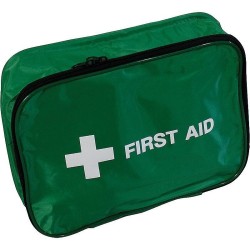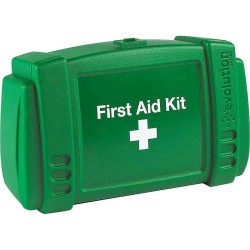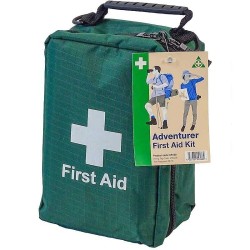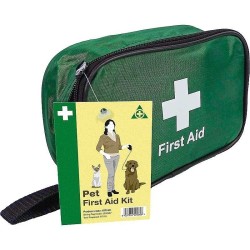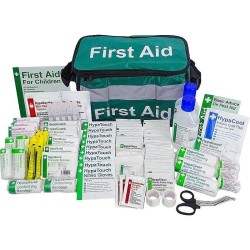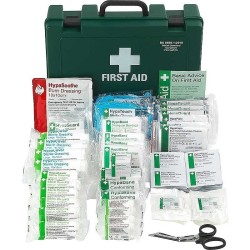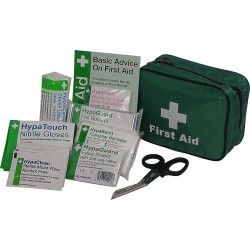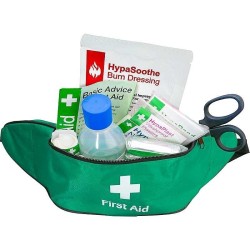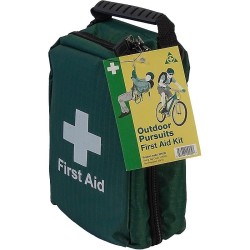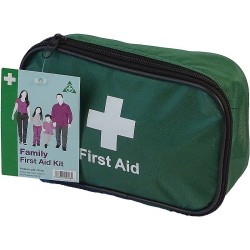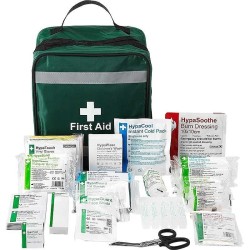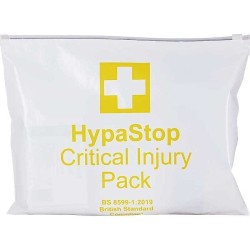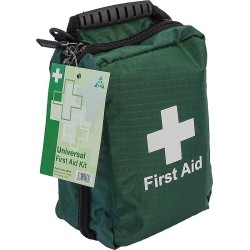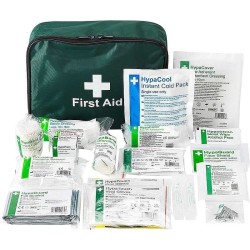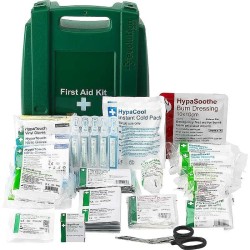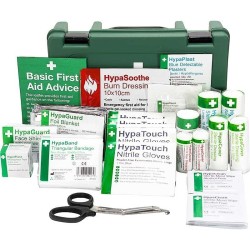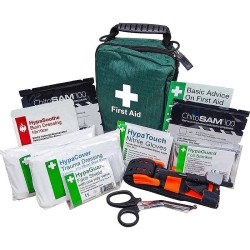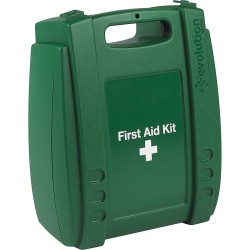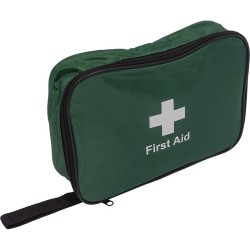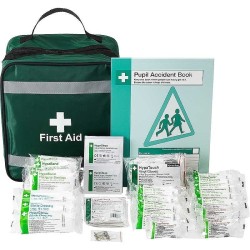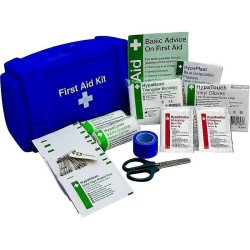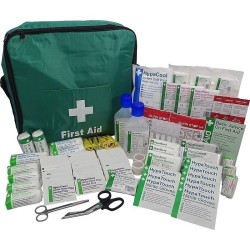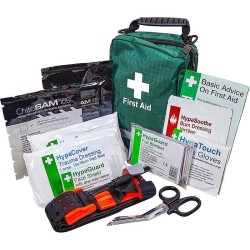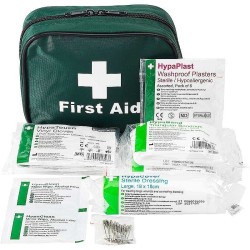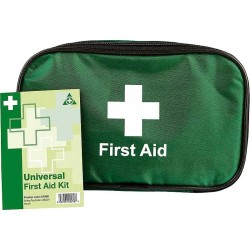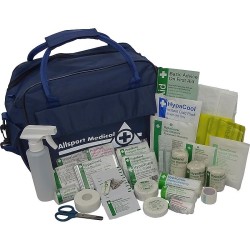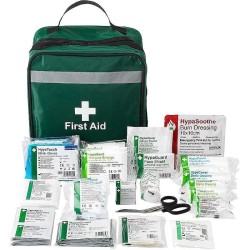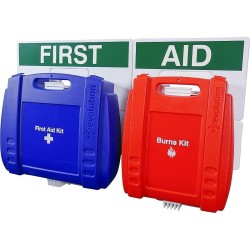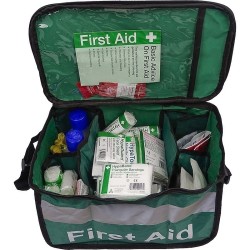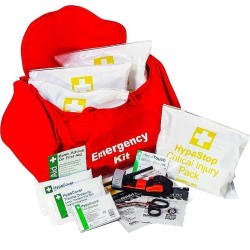First Aid Kits
Subcategories
BS8599-1 First Aid Kits
British Standard Compliant Workplace First Aid Provision
BS8599-1 first aid kits provide British Standard compliant emergency response supplies specifically designed for workplace environments across offices, factories, care facilities, and commercial premises throughout England, Scotland, Wales, and Northern Ireland. These standardised first aid kits follow British Standard BS8599-1 specifications defining appropriate contents, quantities, and kit sizes based on workplace risk assessment, ensuring consistent professional first aid capability. Workplaces rely on BS8599-1 kits for regulatory compliance meeting Health and Safety Executive requirements, appropriate first aid provision matched to assessed risks, standardised contents ensuring consistent capability across locations, professional first aid readiness, and demonstration of employer duty of care. Modern BS8599-1 first aid kits incorporate features including three defined kit sizes for low, medium, and high-risk workplaces, specified contents addressing typical workplace injuries, durable containers protecting contents, clear labelling indicating compliance and contents, and regular content updates reflecting standard revisions. The provision of BS8599-1 compliant first aid kits demonstrates commitment to regulatory compliance, supports workplace safety through appropriate emergency response capability, and fulfils employer legal obligations across professional working environments.
The implementation of BS8599-1 first aid kits directly supports workplace safety compliance, regulatory obligations under health and safety legislation, and demonstration of professional safety management. The Health and Safety (First Aid) Regulations require employers to provide adequate first aid equipment based on workplace risk assessment, with BS8599-1 providing recognised specification for workplace first aid kit contents. BS8599-1 kits address compliance requirements by providing standardised contents matching British Standard specifications, appropriate kit sizes based on workplace risk assessment categories, professional first aid capability addressing typical workplace injuries, and recognised compliance supporting regulatory inspections. Workplace applications include office environments using small low-risk kits, light industrial workplaces requiring medium kits, high-risk environments such as construction or heavy industry needing large comprehensive kits, care facilities requiring professional first aid capability, and commercial premises demonstrating safety compliance. Employers benefit from BS8599-1 kits through clear regulatory compliance, standardised provision simplifying multi-site management, professional first aid capability, and demonstrated duty of care supporting liability management. Modern BS8599-1 kits incorporate features such as guidance leaflets, inventory checklists, and wall-mountable options throughout England, Scotland, Wales, and Northern Ireland.
Selecting and implementing BS8599-1 first aid kits requires workplace risk assessment, appropriate kit size determination, and establishment of first aid management protocols across organisations throughout the UK. Employers must conduct first aid needs assessments considering workplace hazards, injury history, workforce size and distribution, workplace location affecting emergency service access, and employee working patterns including lone workers or shift patterns. Kit selection should follow BS8599-1 specifications with small kits for low-risk workplaces up to 25 employees, medium kits for medium-risk workplaces or low-risk environments with more employees, and large kits for high-risk workplaces, appropriate quantities based on multiple work areas or employee distribution, and suitable containers with wall-mounted cabinets or portable cases matching workplace needs. Implementation protocols must encompass appointed person or first aider designation with appropriate training, strategic kit placement ensuring accessibility typically within two minutes, clear signage indicating locations, and documented inspection schedules checking contents and expiry dates. Quality assurance measures should include regular kit checks using BS8599-1 checklists, restocking procedures replacing used or expired items maintaining specification compliance, incident recording enabling trend analysis and risk assessment review, and periodic needs assessment updates. Modern kit management may incorporate features such as electronic inventory systems, automated expiry alerts, and compliance dashboards. Organisations should establish first aid policies defining responsibilities and procedures, integrate with broader health and safety management, and maintain records demonstrating regulatory compliance. Multi-site organisations should implement consistent approaches, with standardised kit types simplifying management. Staff education should address first aid kit locations, appointed person contacts, and incident reporting. By implementing BS8599-1 first aid kits alongside professional management protocols, organisations throughout England, Scotland, Wales, and Northern Ireland demonstrate their commitment to health and safety compliance, regulatory obligations under first aid regulations, professional workplace safety management, and appropriate emergency response capability supporting employee welfare and demonstrating responsible employer duty of care across all workplace environments.
Childcare First Aid Kits
Specialist Paediatric First Aid for Educational Settings
Childcare first aid kits provide specialist paediatric emergency response supplies specifically designed for children across nurseries, schools, childminders, and childcare facilities throughout England, Scotland, Wales, and Northern Ireland. These purpose-designed kits contain child-appropriate first aid items including smaller plasters, hypoallergenic supplies, and items addressing typical childhood injuries, meeting Early Years Foundation Stage and educational setting requirements. Childcare providers rely on childcare first aid kits for appropriate paediatric first aid provision, regulatory compliance meeting EYFS and school standards, child-friendly supplies reducing distress, professional childcare safety demonstration, and specialist capability addressing childhood injury patterns. Modern childcare first aid kits incorporate features including child-appropriate contents such as smaller plasters and hypoallergenic items, visual aids supporting child communication, comprehensive supplies addressing varied childhood injuries from minor grazes to more serious incidents, durable containers suitable for educational environments, and clear compliance labelling. The provision of childcare first aid kits demonstrates commitment to child safety, supports regulatory compliance in childcare settings, enables appropriate paediatric first aid response, and fulfils professional duty of care across educational environments.
The implementation of childcare first aid kits directly supports child safety, regulatory compliance, and demonstration of professional childcare standards. EYFS requires appropriate first aid provision in early years settings, whilst schools must maintain adequate first aid capability, with children presenting different first aid needs than adults. Childcare kits address these requirements by providing age-appropriate first aid supplies, regulatory compliance supporting EYFS and school standards, child-friendly items reducing distress during treatment, and professional paediatric first aid capability. Childcare applications include nurseries and pre-schools requiring EYFS compliance, primary schools managing childhood injuries, childminders providing home-based care, after-school clubs and holiday schemes, and special educational needs settings. Childcare providers benefit from childcare kits through regulatory compliance, appropriate child-specific provision, professional childcare environment demonstration, and enhanced parent confidence. Modern childcare kits incorporate features such as guidance on childhood injuries, emergency contact templates, and child-appropriate supplies throughout England, Scotland, Wales, and Northern Ireland.
Selecting and implementing childcare first aid kits requires assessment of childcare setting characteristics, regulatory requirements, and appropriate kit specification across settings throughout the UK. Childcare providers should evaluate regulatory requirements particularly EYFS specifications, assess child numbers and age ranges, consider typical childhood injury patterns, and determine appropriate kit quantities for multiple rooms or outdoor areas. Kit selection should prioritise EYFS-compliant contents where applicable, child-appropriate items including smaller plasters and hypoallergenic supplies, comprehensive contents addressing childhood injuries, and suitable containers for childcare environments. Implementation protocols must encompass paediatric first aider provision with appropriate qualifications, strategic kit placement ensuring accessibility, clear injury management procedures including parent notification, and documented kit checks. Quality assurance measures should include regular inspection and restocking, incident recording with parental communication, first aider training maintenance with paediatric focus, and regulatory compliance monitoring. Modern childcare kit management may incorporate parent communication systems and incident analysis. Settings should establish childcare first aid policies, integrate with safeguarding procedures, and maintain detailed documentation. Staff education should address paediatric first aid principles, kit locations, communication with distressed children, and parent liaison. By implementing childcare first aid kits alongside professional protocols, childcare providers throughout England, Scotland, Wales, and Northern Ireland demonstrate commitment to child safety, regulatory compliance with EYFS and educational standards, professional childcare provision, and appropriate paediatric emergency response supporting child welfare across all educational and care settings.
Pet First Aid Kits
Specialist First Aid Supplies for Animal Emergencies
Pet first aid kits provide specialised emergency response supplies specifically designed for domestic animals across pet owners, veterinary practices, groomers, and animal care facilities throughout England, Scotland, Wales, and Northern Ireland. These purpose-designed kits contain animal-appropriate first aid items addressing typical pet injuries and emergencies whilst recognising differences from human first aid, supporting immediate response pending veterinary care. Pet owners and animal care providers rely on pet first aid kits for immediate injury response, emergency capability before veterinary access, travel safety during pet transport, professional animal care demonstration, and responsible pet ownership. Modern pet first aid kits incorporate features including animal-appropriate supplies such as muzzles and pet-safe antiseptics, comprehensive contents addressing varied pet emergencies, guidance specific to animal first aid, durable containers suitable for pet environments, and varied sizes from personal pet owner kits to professional groomer or kennel kits. The provision of pet first aid kits demonstrates commitment to animal welfare, supports responsible pet ownership, enables immediate emergency response, and fulfils duty of care across animal care contexts.
The implementation of pet first aid kits supports animal welfare, emergency preparedness, and responsible pet care. Pets experience injuries and emergencies requiring immediate intervention before veterinary treatment, with appropriate first aid potentially life-saving whilst preventing deterioration. Pet kits address these needs by providing animal-appropriate emergency supplies, immediate response capability supporting survival and welfare, practical items addressing common pet injuries, and professional animal care demonstration. Applications include responsible pet ownership providing home emergency capability, professional groomers and kennels demonstrating animal care standards, veterinary transport services, animal rescue organisations, and working animal services. Pet owners and professionals benefit from pet kits through enhanced animal welfare, immediate emergency response capability, demonstrated responsible care, and preparedness for animal emergencies. Modern pet kits incorporate features such as species-specific guidance, emergency contact templates, and animal handling aids throughout England, Scotland, Wales, and Northern Ireland.
Selecting and implementing pet first aid kits requires consideration of animal types, typical emergency scenarios, and appropriate kit specification across contexts throughout the UK. Pet owners and animal care providers should evaluate typical animals determining species-specific requirements, assess emergency scenarios including injuries and illnesses, consider environments particularly outdoor activities or travel, and determine appropriate kit sizes. Kit selection should prioritise animal-appropriate contents including muzzles, pet-safe antiseptics, and suitable bandaging, comprehensive supplies addressing varied emergencies, guidance on animal first aid recognising differences from human treatment, and suitable containers for animal environments. Implementation should encompass pet first aid training understanding animal emergency response, strategic kit storage ensuring accessibility, clear procedures including veterinary contact, and regular kit checks. Quality assurance measures should include periodic inspection and restocking, incident recording, training updates, and veterinary guidance integration. Modern pet kit management may incorporate veterinary telemedicine contacts. Pet owners should establish emergency procedures, maintain veterinary contact details, and understand kit limitations requiring professional veterinary care. Animal care professionals should integrate pet kits with professional standards and insurance requirements. Education should address animal first aid principles, recognition of serious conditions requiring immediate veterinary care, and safe animal handling during emergencies. By implementing pet first aid kits alongside appropriate knowledge and protocols, pet owners and animal care professionals throughout England, Scotland, Wales, and Northern Ireland demonstrate commitment to animal welfare, responsible pet ownership and care, emergency preparedness, and appropriate immediate response supporting animal health and survival across all domestic animal care contexts.
HSE First Aid Kits
Essential Workplace First Aid Meeting HSE Standards
HSE first aid kits provide fundamental emergency response supplies meeting Health and Safety Executive guidance for workplace first aid provision across offices, shops, light industrial premises, and low-risk commercial environments throughout England, Scotland, Wales, and Northern Ireland. These practical first aid kits contain essential items addressing common workplace injuries whilst remaining more basic than comprehensive BS8599-1 kits, offering cost-effective first aid provision for low-risk workplaces. Employers rely on HSE first aid kits for basic regulatory compliance meeting minimum first aid requirements, appropriate provision for low-risk office and commercial environments, cost-effective first aid capability, straightforward workplace safety implementation, and foundation first aid provision. Modern HSE first aid kits incorporate features including appropriate contents addressing typical minor workplace injuries, practical containers suitable for workplace storage, clear contents listing, reasonable pricing supporting small business compliance, and straightforward implementation. The provision of HSE first aid kits demonstrates commitment to fundamental workplace safety, supports basic regulatory compliance, enables small business first aid provision, and addresses essential emergency response capability across low-risk working environments.
The implementation of HSE first aid kits supports basic workplace safety compliance, meets fundamental employer obligations, and provides practical first aid capability for low-risk environments. Whilst BS8599-1 provides comprehensive standardised specifications, HSE guidance recognises that simpler provision may suffice for genuinely low-risk workplaces. HSE kits address these scenarios by providing essential first aid items sufficient for minor injuries typical in low-risk environments, cost-effective provision supporting small business compliance, practical implementation without excessive complexity, and basic capability meeting regulatory minimum requirements. Workplace applications include small office environments with minimal injury risks, retail premises requiring basic first aid capability, administrative workplaces lacking significant hazards, low-risk commercial premises, and small businesses requiring affordable compliance solutions. Employers benefit from HSE kits through cost-effective basic compliance, straightforward implementation, appropriate provision for genuinely low-risk environments, and practical workplace safety. Modern HSE kits incorporate practical features such as guidance leaflets and basic inventory lists throughout England, Scotland, Wales, and Northern Ireland.
Selecting and implementing HSE first aid kits requires basic workplace risk assessment, appropriate kit determination, and simple first aid management across organisations throughout the UK. Employers should conduct basic risk assessments determining whether genuinely low-risk status justifies simplified provision versus BS8599-1 compliance, consider workforce size and working patterns, assess injury history confirming low-risk status, and evaluate premises characteristics. Kit selection should provide appropriate contents addressing identified risks, ensure adequate quantities for workforce, and include suitable containers. Implementation protocols should encompass appointed person designation, kit location ensuring accessibility, basic signage, and simple inspection schedules. Quality assurance measures should include regular checks, restocking procedures, and incident monitoring. Organisations should establish basic first aid policies, maintain simple records, and ensure staff awareness of kit locations and appointed persons. However, employers should carefully consider whether more comprehensive BS8599-1 provision is appropriate, as many workplaces benefit from standardised compliance. Staff education should address kit locations and reporting procedures. By implementing appropriate first aid kits whether HSE-based or BS8599-1 compliant alongside professional protocols, organisations throughout England, Scotland, Wales, and Northern Ireland demonstrate commitment to workplace safety, regulatory compliance, and emergency response capability appropriate to their environments.
First Responder Kits
Advanced Emergency Medical Supplies for Critical Incidents
First responder kits provide comprehensive advanced emergency response supplies designed for serious incidents across emergency services, industrial sites, remote locations, and high-risk environments throughout England, Scotland, Wales, and Northern Ireland. These professional-grade kits contain advanced medical supplies including trauma dressings, haemostatic agents, airway management equipment, and specialist items addressing life-threatening injuries, supporting critical incident response before ambulance arrival. Professional responders rely on first responder kits for major trauma management, serious bleeding control, airway emergency response, critical incident capability, and enhanced emergency medical intervention. Modern first responder kits incorporate features including advanced trauma supplies such as haemostatic dressings and tourniquets, comprehensive contents supporting varied critical scenarios, professional-grade equipment meeting advanced first aid standards, durable containers suitable for challenging environments, and organised layouts enabling rapid item location during emergencies. The provision of first responder kits demonstrates commitment to emergency preparedness, supports advanced life-saving capability, enables professional critical incident response, and enhances safety in high-risk environments across professional contexts.
The implementation of first responder kits supports advanced emergency response capability, enhanced survival prospects for serious incidents, and demonstration of professional emergency preparedness. Whilst standard first aid kits address minor injuries, serious incidents including major trauma, severe bleeding, or cardiac events require advanced intervention, with first responder kits bridging the gap before ambulance arrival. First responder kits address these critical needs by providing advanced supplies for serious injury management, life-threatening bleeding control using haemostatic agents, airway management equipment, and professional capability extending beyond basic first aid. Applications include emergency services providing on-scene critical care, industrial sites with major incident risks, remote locations where ambulance arrival is delayed, events requiring enhanced medical capability, and high-risk environments demanding advanced preparedness. Organisations benefit from first responder kits through enhanced emergency response capability, improved survival prospects through advanced early intervention, demonstrated safety commitment, and professional emergency management. Modern first responder kits incorporate advanced features such as documentation systems, training aids, and specialised equipment throughout England, Scotland, Wales, and Northern Ireland.
Selecting and implementing first responder kits requires comprehensive risk assessment, appropriate kit specification, and professional training across organisations throughout the UK. Organisations should conduct thorough risk assessments identifying major incident scenarios, evaluate response capabilities and ambulance arrival times, consider regulatory requirements particularly for high-risk industries, and determine appropriate kit specifications. Kit selection should prioritise comprehensive advanced contents including trauma dressings, haemostatic agents, airway equipment, and specialist items, professional-grade supplies meeting clinical standards, appropriate organisation enabling rapid access during emergencies, and robust containers suitable for demanding environments. Implementation protocols must encompass advanced first aid training ideally emergency first response or equivalent qualifications, clear major incident procedures, regular training updates and scenario practice, and documented kit inspections. Quality assurance measures should include detailed inspection schedules, incident debriefing and learning, training competency maintenance, and continuous improvement. Modern first responder kit management incorporates simulation training, performance monitoring, and evidence-based practice updates. Organisations should establish major incident policies, integrate with emergency response plans, and maintain comprehensive documentation. Advanced training should address trauma management, critical decision-making, and team coordination. By implementing first responder kits alongside professional training and protocols, organisations throughout England, Scotland, Wales, and Northern Ireland demonstrate commitment to emergency preparedness, life-saving capability, professional incident response, and enhanced safety supporting critical intervention during serious emergencies across high-risk environments.
Food Service First Aid
Specialized First Aid for Food Service Environments
Food service first aid kits provide specialized equipment addressing injuries common in catering and food preparation environments, containing blue detectable plasters and burn treatment supplies appropriate to food safety and kitchen hazards. These specialized kits support immediate injury management in food service settings while maintaining food safety standards through detectable wound coverings preventing contamination risks, demonstrating compliance with food hygiene regulations alongside employee welfare obligations throughout commercial kitchens, catering operations, and healthcare food service departments.
Catering environments present specific injury risks including burns, cuts, and scalds requiring immediate first aid while maintaining food safety standards. Blue detectable plasters prevent food contamination if dressings become dislodged, addressing food safety concerns alongside wound care. Burn treatment supplies address the thermal injuries common in food preparation. Specialized catering first aid demonstrates awareness of industry-specific hazards while supporting both employee safety and food hygiene compliance throughout food service operations.
Commercial kitchens, catering companies, hospital food services, and food production facilities can implement specialized catering first aid provision meeting both health and safety and food hygiene requirements. Blue detectable contents address food safety concerns, burn treatment supplies suit thermal injury risks, and appropriate item selection reflects catering hazard profiles. Environmental health inspections may assess first aid provision as part of food safety audits. Catering first aid kits demonstrate comprehensive risk management addressing both employee welfare and food safety throughout food service operations.
Sports First Aid Kits
Specialist First Aid for Athletic and Sports Injuries
Sports first aid kits provide specialised emergency response supplies specifically designed for athletic injuries across sports clubs, schools, leisure centres, and sporting venues throughout England, Scotland, Wales, and Northern Ireland. These purpose-designed kits contain enhanced provisions addressing typical sports injuries including strains, sprains, impact injuries, bleeding, and overexertion conditions, offering comprehensive pitch-side and changing room first aid capability. Sports organisations rely on sports first aid kits for immediate injury response during training and competition, management of common athletic injuries, pitch-side treatment capability, changing room first aid provision, and demonstration of participant duty of care. Modern sports first aid kits incorporate features including specialist items such as cohesive bandages for joint support, instant cold packs for impact injuries, larger quantities of items addressing multiple participants, durable weather-resistant containers suitable for outdoor use, and comprehensive contents supporting varied injury scenarios. The provision of sports first aid kits demonstrates commitment to participant safety, supports immediate injury management enabling appropriate treatment decisions, fulfils duty of care obligations, and enables professional sports injury response across athletic environments.
The implementation of sports first aid kits directly supports participant safety, appropriate injury management, and demonstration of professional sports organisation. Sports activities inherently involve injury risks including muscle strains, ligament sprains, impact injuries, cuts and grazes, and heat-related conditions, requiring immediate first aid response. Sports kits address these requirements by providing specialist items for common sports injuries, immediate treatment capability at pitch-side or changing rooms, comprehensive supplies supporting multiple participants during events, and professional injury management pending medical review. Sports applications include team sports requiring pitch-side treatment capability, individual sports needing changing room provision, school sports ensuring student safety, leisure centres supporting varied activities, and sporting events providing comprehensive first aid. Sports organisations benefit from sports kits through enhanced participant safety, immediate injury management reducing severity through early treatment, demonstrated duty of care supporting reputation and liability management, and professional sporting environment presentation. Modern sports kits incorporate advanced features such as specialist injury assessment guides, thermal blankets, and sports-specific supplies throughout England, Scotland, Wales, and Northern Ireland.
Selecting and implementing sports first aid kits requires assessment of sporting activities, appropriate kit specification, and integration with sports safety protocols across organisations throughout the UK. Sports organisations should evaluate typical activities and associated injury risks, assess participant numbers influencing kit sizes, consider environment including outdoor versus indoor settings, and determine kit quantities based on multiple pitches or facilities. Kit selection should prioritise appropriate contents addressing identified sports injuries, sufficient quantities supporting multiple participants, specialist items such as cohesive bandages and cold packs, weather-resistant containers for outdoor sports, and portable designs enabling pitch-side availability. Implementation protocols must encompass qualified first aider provision with appropriate sports first aid training, strategic kit placement ensuring pitch-side accessibility, clear protocols for injury management, and documented kit checks. Quality assurance measures should include regular inspection and restocking, incident recording enabling trend analysis, first aider training maintenance, and periodic risk assessment review. Modern sports kit management may incorporate tournament-specific preparation and equipment tracking. Organisations should establish sports first aid policies, integrate with broader participant safeguarding, and maintain documentation. Staff and volunteer education should address kit locations, first aider identification, and injury reporting. By implementing sports first aid kits alongside professional protocols, organisations throughout England, Scotland, Wales, and Northern Ireland demonstrate commitment to participant safety, appropriate sports injury management, duty of care, and professional sporting environments supporting immediate effective injury response across all athletic activities.
General Purpose First...
Versatile Compact Emergency Response for Varied Settings
General purpose first aid kits provide versatile compact emergency response supplies suitable for varied environments across homes, small workplaces, travel, vehicles, and general contexts throughout England, Scotland, Wales, and Northern Ireland. These practical kits contain fundamental first aid items addressing common minor injuries and emergencies including plasters, dressings, bandages, wipes, and essential supplies, offering convenient comprehensive capability in portable packages. Individuals and small organisations rely on general purpose kits for home first aid preparedness, personal travel safety, vehicle emergency supplies, small office provision, and versatile emergency capability. Modern general purpose kits incorporate features including compact sizes enabling convenient storage and portability, comprehensive contents addressing common injuries, durable containers protecting supplies, clear contents listing, and cost-effective provision. The provision of general purpose first aid kits demonstrates commitment to emergency preparedness, supports immediate injury response across varied settings, enables versatile first aid capability, and fulfils fundamental safety requirements across domestic and small workplace contexts throughout everyday environments.
The implementation of general purpose first aid kits supports personal emergency preparedness, versatile injury management capability, and demonstration of responsible safety planning. Varied settings from homes through travel require accessible first aid supplies addressing common injuries. General purpose kits address these needs by providing versatile contents suitable for typical injuries across contexts, delivering compact portable emergency capability, enabling convenient storage in varied locations, supporting cost-effective comprehensive provision, and demonstrating responsible preparedness. Application scenarios include home first aid for family accidents, personal travel emergency supplies, vehicle safety provision, small workplace first aid, and general emergency preparedness. Individuals and organisations benefit from general purpose kits through versatile preparedness, convenient comprehensive provision, portable emergency capability, and cost-effective safety. Modern general purpose kits incorporate features such as organised compartments, waterproof containers, and varied sizes throughout England, Scotland, Wales, and Northern Ireland.
Selecting and implementing general purpose first aid kits requires assessment of intended contexts, appropriate specification, and integration with personal or organisational safety planning throughout the UK. Individuals and small organisations should evaluate typical uses determining kit size and contents requirements, assess portability needs particularly for travel or vehicle kits, consider storage constraints, and determine appropriate quantities for multiple locations. Kit selection should prioritise appropriate size balancing comprehensive contents with portability and storage constraints, suitable contents addressing common injuries, durable containers protecting supplies whilst enabling access, clear contents information supporting use, and cost-effective provision. Implementation approaches should encompass strategic placement in accessible locations, basic first aid knowledge or training, periodic kit checks ensuring completeness and addressing expiry dates, and simple restocking procedures. Quality assurance measures should include regular inspection schedules, documented checks for household or small workplace compliance, restocking when items are used, and consideration of specialised additions based on specific needs. Modern general purpose kit management may incorporate mobile applications providing first aid guidance. Individuals and organisations should establish basic first aid preparedness including kit availability, basic knowledge or training, and emergency procedures. Multiple kits benefit larger homes or workplaces ensuring accessibility. Education should address kit locations, basic first aid principles, when professional medical assessment is required, and kit maintenance. Storage should balance accessibility for emergencies with protection from damage and temperature extremes. By implementing general purpose first aid kits alongside basic preparedness, individuals and organisations throughout England, Scotland, Wales, and Northern Ireland demonstrate commitment to emergency response capability, responsible safety planning, versatile injury management readiness, and comprehensive preparedness supporting immediate appropriate first aid response across all domestic, travel, vehicle, and small workplace contexts requiring accessible emergency medical supplies.
Vehicle First Aid Kits
Compact Emergency Medical Supplies for Road Safety
Vehicle first aid kits provide compact emergency response supplies specifically designed for road transport across private cars, commercial vehicles, fleet operations, and mobile services throughout England, Scotland, Wales, and Northern Ireland. These space-efficient kits contain essential first aid items addressing road traffic incident injuries whilst remaining appropriately sized for vehicle storage, supporting emergency response capability during travel. Vehicle users rely on vehicle first aid kits for accident and incident response, emergency medical capability away from fixed facilities, regulatory compliance for commercial vehicles, fleet safety provision, and personal preparedness during travel. Modern vehicle first aid kits incorporate features including compact packaging fitting vehicle storage spaces, durable containers withstanding vehicle environments, essential contents addressing typical traffic incident injuries, clear labelling enabling quick identification during emergencies, and varied sizes from personal car kits to comprehensive fleet kits. The provision of vehicle first aid kits demonstrates commitment to road safety, supports emergency preparedness during travel, fulfils commercial vehicle requirements, and enables immediate incident response across mobile and transport contexts.
The implementation of vehicle first aid kits supports road safety, emergency preparedness, and regulatory compliance for commercial transport. Road travel involves accident and incident risks requiring immediate first aid response before emergency services arrive, with vehicle kits enabling early treatment. Vehicle kits address these needs by providing essential first aid capability during travel, compact provision suitable for vehicle storage, immediate response capability at incident scenes, and regulatory compliance for commercial vehicles. Applications include private car safety for personal and family travel, commercial vehicle compliance meeting transport regulations, fleet operations ensuring consistent vehicle safety provision, mobile service vehicles including healthcare and emergency services, and long-distance travel requiring self-sufficiency. Vehicle operators benefit from vehicle kits through enhanced road safety, immediate incident response capability, regulatory compliance for commercial operations, and demonstrated duty of care. Modern vehicle kits incorporate features such as hi-visibility storage, emergency contact information, and temperature-stable contents throughout England, Scotland, Wales, and Northern Ireland.
Selecting and implementing vehicle first aid kits requires assessment of vehicle types, regulatory requirements, and appropriate kit specification across organisations and individuals throughout the UK. Users should evaluate vehicle types determining storage constraints, assess regulatory requirements particularly for commercial vehicles where first aid kit provision may be required, consider journey characteristics including remote travel versus urban use, and determine appropriate kit sizes. Kit selection should prioritise compact design suitable for vehicle storage, essential contents addressing traffic incident injuries, durable containers withstanding vehicle environments including temperature variations, and appropriate quantities with larger kits for commercial vehicles. Implementation protocols should encompass strategic storage locations ensuring accessibility whilst preventing movement during travel, driver awareness of kit locations and contents, regular inspection schedules, and restocking procedures. Quality assurance measures should include periodic kit checks particularly for commercial fleets, expiry date monitoring in vehicle environments potentially accelerating degradation, documented inspection records for commercial compliance, and incident recording. Modern vehicle kit management may incorporate fleet tracking systems. Commercial operators should establish vehicle first aid policies, integrate with broader fleet safety management, and maintain compliance documentation. Driver education should address kit locations, basic first aid capability, and emergency procedures. By implementing vehicle first aid kits alongside appropriate protocols, organisations and individuals throughout England, Scotland, Wales, and Northern Ireland demonstrate commitment to road safety, emergency preparedness, regulatory compliance for commercial operations, and responsible travel safety across all vehicle and journey types.
First Aid Kit Refills
Essential Replacement Supplies for Kit Maintenance
First aid kit refills provide vital replacement supplies maintaining first aid kit stocks and ensuring continued emergency response capability across workplaces, care facilities, educational settings, and varied environments throughout England, Scotland, Wales, and Northern Ireland. These essential replacement items encompass individual first aid supplies including plasters, dressings, bandages, cleansing wipes, gloves, and varied consumables requiring replenishment following use or expiry. Organisations rely on first aid kit refills for restocking kits after incident use, replacing expired items maintaining compliance, establishing stock reserves, responding to increased usage patterns, and maintaining multiple kit locations. Modern first aid refills incorporate features including specification-matched contents supporting BS8599-1 or HSE compliance, varied pack sizes from individual items to bulk quantities, clear expiry dates supporting stock management, sterile packaging ensuring hygiene, and cost-effective pricing supporting budget management. The availability of comprehensive first aid refills ensures continuous emergency response capability, prevents kit depletion compromising safety, supports regulatory compliance through maintained kit standards, and demonstrates professional first aid management across professional environments.
The provision of appropriate first aid kit refills directly supports emergency preparedness, regulatory compliance, and professional safety management. First aid kits require regular replenishment, with used items needing immediate replacement and expired items requiring disposal, making refill availability essential for maintained capability. First aid refills address these requirements by enabling prompt kit restocking maintaining emergency readiness, supporting compliance with specified kit contents, preventing dangerous kit depletion during high-incident periods, and ensuring item quality through replacement before expiry. Refill management applications include routine restocking following scheduled kit checks, incident response replacing used items immediately, expiry date management maintaining fresh stocks, bulk replenishment for multiple kit locations, and emergency restocking during unusual demand. Organisations benefit from first aid refills through maintained emergency capability, regulatory compliance meeting kit standards, cost-effectiveness through targeted replacement versus complete kit replacement, and professional safety management. Modern refill supply approaches incorporate subscription services, bulk discounts, and integrated inventory management throughout England, Scotland, Wales, and Northern Ireland.
Selecting and implementing first aid refill management requires stock assessment, appropriate item specification, and establishment of replenishment protocols across organisations throughout the UK. Safety managers should evaluate first aid kit inventories identifying required refills, assess usage patterns determining typical consumption rates, review expiry date cycles identifying replacement needs, and calculate stock requirements ensuring adequate reserves. Refill selection should match specified kit contents particularly BS8599-1 or HSE standards, prioritise appropriate items addressing typical usage, ensure adequate quantities preventing stockouts, consider bulk purchasing for cost-effectiveness, and maintain quality meeting medical device standards where applicable. Implementation protocols should encompass regular kit inspections using checklists documenting contents, restocking procedures with designated responsibilities, expiry date monitoring using first-in-first-out rotation, and incident recording identifying usage patterns. Quality assurance measures should include documented inspection schedules, supplier management ensuring reliable supply, storage protocols protecting consumables, and budget monitoring. Modern refill management may incorporate electronic inventory systems, barcode tracking, and automated reordering. Organisations should establish clear first aid policies defining restocking responsibilities and standards, integrate with procurement systems, and maintain compliance documentation. Storage should ensure clean, dry conditions within appropriate temperatures whilst maintaining accessibility. Staff education should address kit inspection, item usage recognition, reporting procedures, and restocking protocols. Procurement should balance cost considerations with quality requirements and supply reliability. By implementing comprehensive first aid refill management alongside professional protocols, organisations throughout England, Scotland, Wales, and Northern Ireland demonstrate commitment to health and safety compliance, maintained emergency response capability, professional safety management, and responsible equipment stewardship ensuring first aid kits remain properly stocked and effective supporting immediate injury management across all working and public environments.




